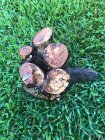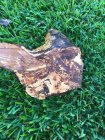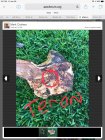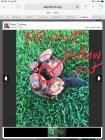-
August 2025 Turning Challenge: Wooden Version of Non-Wood Item! (click here for details) -
Congratulations to David Croxton for "XOXOXO" being selected as Turning of the Week for August 11, 2025 (click here for details) -
Welcome new registering member. Your username must be your real First and Last name (for example: John Doe). "Screen names" and "handles" are not allowed and your registration will be deleted if you don't use your real name. Also, do not use all caps nor all lower case.
You are using an out of date browser. It may not display this or other websites correctly.
You should upgrade or use an alternative browser.
You should upgrade or use an alternative browser.
what would you make with this?
- Thread starter Mark Corkern
- Start date
- Joined
- Apr 27, 2004
- Messages
- 9,247
- Likes
- 5,906
- Location
- Lakeland, Florida
- Website
- www.hockenberywoodturning.com
This could be a very dangerous piece to turn. Punky wood combined with bark inclusions
Make the structural integrity questionable.
Unless you have a lot of experience working with structural defects, I recommend. cutting it into small pieces for bottle stoppers and pens. You could stabilize the punky blocks.
The bark inclusion have no structural integrity as soon as you cut through the small bits of wood holding the pice together the trunk sections will detach becoming dangerous flying objects. Below one of the bark inclusions is showling on the sawn face the others. Are likely not too deep.
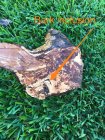
Make the structural integrity questionable.
Unless you have a lot of experience working with structural defects, I recommend. cutting it into small pieces for bottle stoppers and pens. You could stabilize the punky blocks.
The bark inclusion have no structural integrity as soon as you cut through the small bits of wood holding the pice together the trunk sections will detach becoming dangerous flying objects. Below one of the bark inclusions is showling on the sawn face the others. Are likely not too deep.

Last edited:
I agree, not worth the risk. One or more of those 5 sections could very easily launch!
No punky wood at all.
I’d make a bowl for sure. Strap it to a piece of plywood with some screws of something and turn a tenon on the bottom then grab by tenon , an there you have a bowl form . Start turning. Would be beautiful little piece . I look for pieces of wood like that!
Adherement or compliance
Only way I would mess with that would be to soak every crevice with thin CA then cast itinto a block of Alumilite.
It could make a very interesting piece. I agree with a tenon for mounting. If you give it a go, make sure to stand out of the line of fire at all times!!!!!!! Personally I wouldn't turn a piece like that. Some do like the challenge of taking the nastiest piece of wood they can find and then make some thing out of it...
robo hippy
robo hippy
You could approach this from the opposite direction and use the flat side as a platter and carve the limbs into equal length feet to set it on a table.
This would be similar to large root balls that are made into tables with the roots being the legs. The difficult part would be supporting the piece while turning the platter side of the piece. You could drill a recess or glue a tenon on the flat side and then mount the piece in a chuck then turn all of the legs to the same height and then glue a flat round board to the feet to allow reverse chucking on the flat round board and then finish turning the platter side and then remove the flat round board and finish carving the legs. If you are looking for a challenge which the piece you have chosen seems to indicate then this would definitely add to the challenge. This method would provide the largest surface area of figured grain available in the piece you have. You could also just cut all of the limbs off and turn a flat platter which would also maximize the figured grain you have to work with,
This would be similar to large root balls that are made into tables with the roots being the legs. The difficult part would be supporting the piece while turning the platter side of the piece. You could drill a recess or glue a tenon on the flat side and then mount the piece in a chuck then turn all of the legs to the same height and then glue a flat round board to the feet to allow reverse chucking on the flat round board and then finish turning the platter side and then remove the flat round board and finish carving the legs. If you are looking for a challenge which the piece you have chosen seems to indicate then this would definitely add to the challenge. This method would provide the largest surface area of figured grain available in the piece you have. You could also just cut all of the limbs off and turn a flat platter which would also maximize the figured grain you have to work with,
Unless the piece has sentimental value, not sure I would do something with this. Or, someone would have to pay me in advance to do it. Wearing my 3M Airstream helmet is a given with a piece like this. I definitely see some punky areas, as well as bark intrusion, it sure is spalted, one step away from punky and then rotten.
Personally, I think this would be a really fun piece.
I would mount up view #1 and carve it into a bowl.
If its punky, then dry it and soak it in thinned down epoxy resin and let it dry.
Should hard and easy to turn after that.
I would mount up view #1 and carve it into a bowl.
If its punky, then dry it and soak it in thinned down epoxy resin and let it dry.
Should hard and easy to turn after that.
You could approach this from the opposite direction and use the flat side as a platter and carve the limbs into equal length feet to set it on a table.
This would be similar to large root balls that are made into tables with the roots being the legs. The difficult part would be supporting the piece while turning the platter side of the piece. You could drill a recess or glue a tenon on the flat side and then mount the piece in a chuck then turn all of the legs to the same height and then glue a flat round board to the feet to allow reverse chucking on the flat round board and then finish turning the platter side and then remove the flat round board and finish carving the legs. If you are looking for a challenge which the piece you have chosen seems to indicate then this would definitely add to the challenge. This method would provide the largest surface area of figured grain available in the piece you have. You could also just cut all of the limbs off and turn a flat platter which would also maximize the figured grain you have to work with,
This is what I am leaning towards, thanks
Maybe consider bandsawing and carving...a whole lot safer, and you still get to use some pretty wood.

